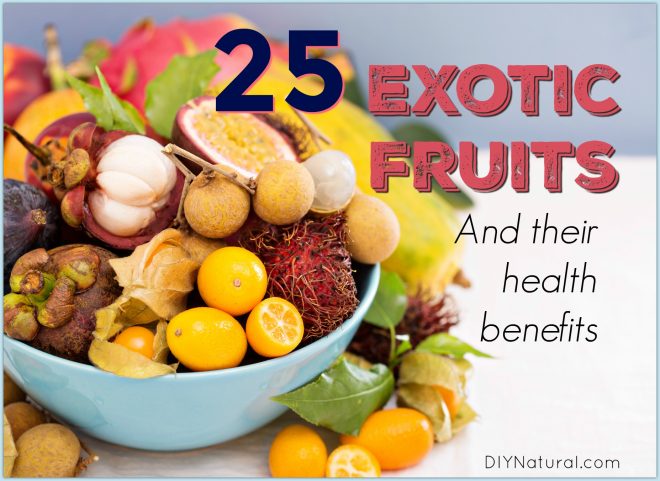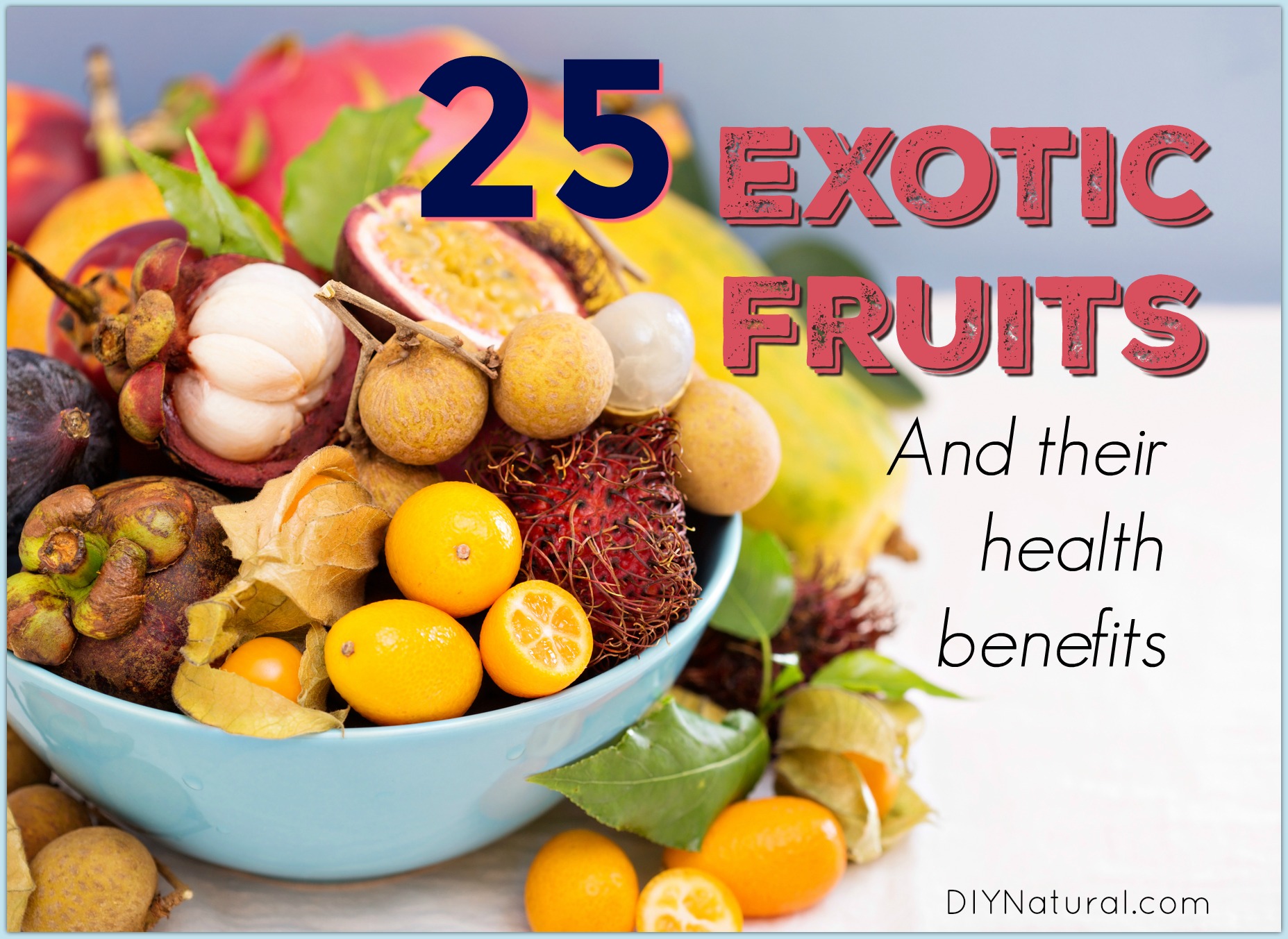
I saw some of the most interesting, exotic fruits when I lived in Florida. But I was always curious about the health benefits they might have. Here’s a list of 25 of my favorites and reasons you should try them!
25 Exotic Fruits That Support Health
1. Horned Melon
These yellow to orange fruits look like a spiny overgrown cucumber. They come from Africa and do taste like a combination of cucumber and zucchini. They are full of Vitamin C and fiber.
2. Sapote
My favorite Sapote is the Black Sapote. Its flesh tastes just like chocolate pudding! It comes from Central and South America and contains significant amounts of vitamins A and C, iron, and phosphorus. (Sapote oil from the Mamey sapote tree has also been shown to balance oil production when used on the scalp or face. Find it here.)
3. Mangosteen
Mangosteen is indeed a member of the Mango family. It has a sweet and tangy flesh, somewhat like a peach. It contains large amounts of antioxidants. (Find organic mangosteen fruit powder here for mixing into smoothies, drinks, and more.)
4. Carambola (Star Fruit)
This fruit is star-shaped and often dark yellow. It is both sweet and tart, and very juicy. Choose the fruits with a bit of brown along the edges for the highest amount of Vitamin C.
5. Passion Fruit (Maypop)
Native to many parts of the world, Passion Fruit comes in many colors. The taste is somewhat bland in ripe fruit, but it is known to enhance the flavor of almost any other fruit. It is high in vitamins A, C, and E.
6. Buddha’s Hand
This very odd-looking citrus fruit has no value in its flesh, but in its rind. It is related to citron and is often candied or the zest is used to flavor dishes. (Check out this California olive oil that has fresh Buddha’s Hand added to it.) It is very high in Vitamin C.
7. Dragon Fruit
This is actually the fruit of a cactus. It is football-shaped and looks like it has scales on the outside, much like a dragon. The fruit is bright red/pink on the outside and white with tiny black seeds on the inside. Despite the bland appearance, it is surprisingly tart, much like a kiwi. It contains a high amount of bioflavinoids.
8. Lychee
These are roughly grape-sized with a hard shell. Peel the shell open to reveal a clear juicy flesh, very much like grapes. They are high in Vitamin C.
9. Longan
Longans taste much like a melon and look like an apricot. They are sweet, tangy, and juicy and contain a lot of Vitamin C and A. (Add these organic dried longan fruit pieces to trail mixes!)
10. Surinam Cherry
This red fruit makes a nice hedge in your yard (with a sweet juicy fruit as an added bonus). It is about the size of a ping pong ball with ribs, much like a little pumpkin. Like many other fruits of color, it is high in antioxidants.
11. Rambutan
This small fruit looks like it has hair on the outside. It comes from Malay and has a sweet/sour taste, and is also very high in Vitamin C.
12. Physalis (Ground Cherry)
This fruit is encased in a husk, earning it the nickname “Lantern Fruit.” We ate them in sauce and pie growing up, but many people regard them as weeds. They are very tart and contain a lot of ascorbic acid. (If you can’t find them fresh, try dried physalis.)
13. Jabuticaba
Jabuticaba is a lot like grapes, and is often used in jam and liqueur. This South American fruit is also very high in antioxidants.
14. Durian
If you can get past the smell of the outside, the flesh has a wonderful custard-like melon flavor. Durian has a safety measure in that the flesh in encased in a foul-smelling, thorned armor. It contains a lot of calcium and phosphorus.
15. Jakfruit
Like the Durian, the Jakfruit also has an unpleasant odor. The flesh is firm and tastes much like strawberries, cantaloupe, and banana all in one. It is sometimes dried and sold as chips, and has even been used as a vegan meat substitute. There is a harsh latex-like liquid in the skin that makes it difficult to get apart, but the prize is well worth the effort. The fruit is large, often 60-80 pounds! The seeds are often roasted and sold as a treat on street corners.
16. Miracle Fruit
This fruit has the unique ability to make sour food taste sweet, therefore making it useful in helping to wean individuals off of sugar.
17. Cherimoya
This fruit is a cousin of Atemoya and Custard Apples. It is an apple-sized fruit that comes from the Andes Mountains. Cherimoya fruit tastes like custard and is a bit grainy. It contains significant amounts of calcium.
18. Pepino
I’ve seen a lot of these in grocery stores lately. They are a smaller pale yellow fruit with purple stripes. It is a relative of the tomato and eggplant. It tastes much like a cross between a melon and a pear and has a significant amount of Vitamin C.
19. Canistel
This comes from Mexico and is quite firm, not juicy. It is used in custards and ice cream, and is high in calcium.
20. Chayote
Many regard this odd looking fruit as a vegetable. It can be cooked or eaten raw. This plant is easy to grow in the heat of summer. Simply plant, give it room to climb, and the vine will start growing out of the center. Chayotes are high in Vitamin A.
21. Cucamelon
This tiny fruit looks like a miniature watermelon. It comes from Mexico and Central America. It grows on a vine and is very sour, containing a lot of ascorbic acid.
22. Soursop
This fruit has large seeds and tastes like strawberry/pineapple. It comes from South America and contains large amounts of Vitamin C.
23. Sapodilla
This potato lookalike is super sweet. It comes from Mexico and is full of antioxidants.
24. Paw Paw
These long, oval fruits are from the Southeast US. They are like custard on the inside and taste somewhat like a banana. These contain large amounts of calcium.
25. Yuzu
This citrus fruit is the only one of the citrus family that can be grown above the frost line. It is very tart and is mostly used as a flavoring. The peel is made into essential oil (find it here) and is used in soaps and lotions. It is very high in Vitamin C.
What about you? Have you tried any of these exotic fruits? Did we forget any?
*******




I’m sure I have eaten many of these, but it’s hard to tell without a picture. They likely have different names in Mexico. I recognize several of the fruits in the basket of fruits in the photo. The dragon fruit Pitahaya in Mexico was easy to recognize by your description. Also the many types of passion flower fruit, Otherwise I’m guessing. Pictures would be good.
You are right, Nora. Unfortunately, my camera doesn’t take the right sized photos. I’m working on that. If nothing else, maybe I can inculde links to photos next time. Thanks for the suggestion!